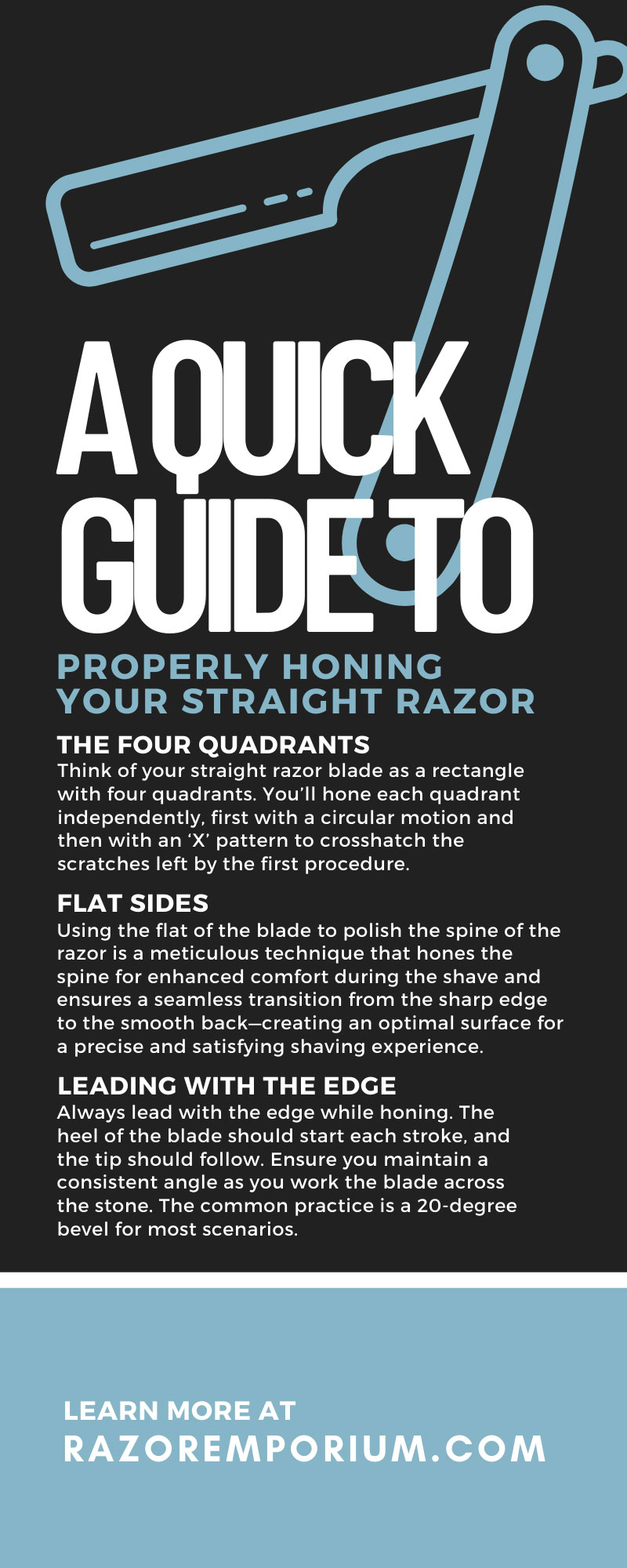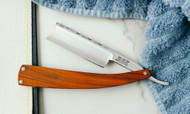A Quick Guide to Properly Honing Your Straight Razor
4th Apr 2024
There’s something inherently satisfying about the meticulous process of honing a straight razor. It’s an art form that hearkens back to classic grooming rituals, a traditional practice that elevates each shave to a refined experience. Honing and maintaining a straight razor ensures a quality shave and symbolizes attention to detail and self-reliance for the modern man, especially one seeking a deeper connection to his grooming routine.
A straight razor’s honing process is a critical skill in the realm of men’s grooming. A shroud of tradition, mystery, and a fair bit of caution often surrounds this activity, but it need not be an intimidating endeavor. We’ve tailored this quick guide to properly honing your straight razor for enthusiasts eager to master the process. You’ll find all the insights necessary to hone your blade to a mirror-like finish, whether you’re new to the straight razor world or a seasoned aficionado looking to refine your technique —no barber experience required!
Why Honing Is Essential
Understanding why this step is so pivotal in straight razor maintenance is crucial before you begin the honing process. Honing is akin to the periodic sharpening of kitchen knives—it’s an essential practice for two primary reasons.
Close Shave
Honing your blade is a must if you desire the closest shave possible. A properly honed razor will cut through hair with minimal effort, delivering an exceptionally close shave. Unlike a dull blade that tugs at hairs, a sharp edge slices through them cleanly, reducing the likelihood of ingrown hairs and irritations.
Longevity
Also, consistent and correct honing will assist you with this goal if you want your razor to last as long as possible. Honing helps maintain the edge, preserving the blade for a longer time by removing the microscopic nicks and burrs that accumulate with each shave. Therefore, honing your blade will help fix problems before they become worse. These small irregularities can lead to your razor becoming unusable if you allow them to develop.
Step-by-Step Honing Process
Now that we know why honing is important, let’s cover how you can do this process. By mastering the honing technique, you’ll have a sharp blade every time you shave. You’ll need to follow this set of rules to do this correctly. Each of these steps plays a critical role in refining your straight razor’s edge.
Preparation
Understanding Your Stone
You must understand how a sharpening stone can hone your razor before selecting one. A high-quality sharpening stone, such as water stones or wet/dry sandpaper adhered to a flat surface, is essential. Stones come in different grits, which refers to their level of abrasiveness. Lower numbers indicate coarser grits, while higher numbers correspond to finer grits. You’ll typically use successive grits starting from a lower number (200-600) to remove material, through intermediate (800-2000) to refine the edge, and end with a high grit (4000-8000) to polish.
Lapping Your Stone
Ensure your stone is flat before you begin honing. A slightly curved or non-flat stone can result in a curved blade over time. Lapping refers to the process of grinding the face of the stone to ensure it’s completely level. You can use a lapping plate or another stone of a similar or coarser grit for this purpose. Just make sure you mark the stone before lapping it to know when it’s completely flat.
Honing Techniques
The Four Quadrants
Think of your straight razor blade as a rectangle with four quadrants. You’ll hone each quadrant independently, first with a circular motion and then with an ‘X’ pattern to crosshatch the scratches left by the first procedure.
Flat Sides
Using the flat of the blade to polish the spine of the razor is a meticulous technique that hones the spine for enhanced comfort during the shave and ensures a seamless transition from the sharp edge to the smooth back—creating an optimal surface for a precise and satisfying shaving experience.
Leading With the Edge
Always lead with the edge while honing. The heel of the blade should start each stroke, and the tip should follow. Ensure you maintain a consistent angle as you work the blade across the stone. The common practice is a 20-degree bevel for most scenarios.
Testing Sharpness
The HHT
Holding the Hairs Test (HHT) is a popular test used to check if the blade is sharp enough. Place a single strand of hair (typically a strand of head hair) perpendicular to the blade and gently touch it. A sharp razor will easily slice through the hair with no pressure.
The Thumbnail Test
An experienced shaver might perform the Thumbnail Test. Running the blade across the pad of the thumb should leave a slight hanging that can be felt. This method requires caution and you must perform it judiciously.
Tips for Maintenance and Care
While the intent of this quick guide to properly honing your straight razor is to teach you how to keep your straight razor sharp, knowing how to maintain the blade is just as crucial. Proper maintenance will extend a straight razor’s life and ensure you’re always ready for that perfect shave.
Storing the Razor
Proper storage is the first step to maintaining your blade. You should always store your straight razor in a dry environment to prevent rust. Wooden boxes with felt insides or leather pouches provide excellent protection. It is also wise to store the razor in a vertical position if possible to prevent the edge from dulling over time.
Regular Honing Schedule
While the frequency of honing depends on how often you shave and the coarseness of your facial hair, you should still try to keep to a regular schedule. Monthly honing is sufficient to maintain a sharp edge, but you can go longer between sessions in some cases. Keep track of your honing schedule to ensure your blade remains in prime condition.
Importance of Stropping
Stropping is not honing, but it’s an indispensable step in maintaining a straight razor. Stropping is a process that you should perform before every shave to align the delicate edge and remove any trace of moisture that may have settled on the blade, which could lead to corrosion. Doing this before every use will reduce the need to hone your blade. Be sure to use smooth, non-abrasive leather for your strop, and remember that excessive stropping can actually dull your blade.
One Final Tip
Honing your straight razor is not an activity you should rush. It’s a meditative practice that embodies the very essence of slow living in the fast-paced modern world. It offers a moment of respite to craft a tool that, for a brief instance, transforms a daily routine into a timeless tradition.
Razor Emporium is here to help if straight-edge shaving is something you’d like to get in on or you’d simply like to expand upon the technique. We have a fine selection of straight-blade razors for you to choose from, so take the time today to find the one that’s right for you.







